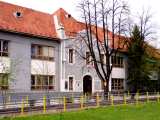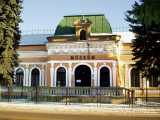| | I | | | | | |  The
town is situated in the Rožňava Fold in the valley of the Slaná River,
under the southern foothills of the Volovské Mountains. Rožňava emerged
as a miners' settlement with golden, silver, and copper mines. The
first written mention of the town dates back to 1291. The first
municipal rights were granted in 1340, the town became a tributary town
in 1382, and it gained full recognition as a free royal town in 1410.
Turkish raids in the 16th century contributed to the decline of mining.
Today, Rožňava is a pleasant town with excellent opportunities for
nature and history lovers. The
town is situated in the Rožňava Fold in the valley of the Slaná River,
under the southern foothills of the Volovské Mountains. Rožňava emerged
as a miners' settlement with golden, silver, and copper mines. The
first written mention of the town dates back to 1291. The first
municipal rights were granted in 1340, the town became a tributary town
in 1382, and it gained full recognition as a free royal town in 1410.
Turkish raids in the 16th century contributed to the decline of mining.
Today, Rožňava is a pleasant town with excellent opportunities for
nature and history lovers. | | |
 | | | 
 |
KLIK
FOTO
= INFO+

| 
 | |
The house of the former town's almshous
built in 1719. There are older baroque stone sculptures: The Holy
Trinity and Piety and the statuary of St. Florian, the patron of
firemen, carved by anonymous sculptor in 1720. A plaque on the
facade of the almshouse commemorates the yeoman of Krasna Horka Juraj
Andrassy, who had the almshouse built for poor and ill people from
Rožňava. Under the plaque there is a small tabernacle with ironwork for
a contribution box used ot collect the money for the almshouse. Since
1837, based on the edict of catholic council, the almshouse was renamed
to "roman-catholic" and only served for catholics. ........... | | |  | | Former Evangelical Gymnasium
(Grammar School).Several important people studied here: Július Botto -
historian, Pavol Dobšinský - writer, Zoltán Fábry - writer, Michal
Miloslav Hodža - politician, Peter Kellner Hostinský - poet and
journalist, Akad.Jur Hronec - mathematician, András Cházár - pioneer
ofmedical pedagogy, Viktor Madarász - painter, Jozef Mikulík -
historian, Michal Mišovic - drama writer, rector, Samuel Ormis -
pedagogue, Albert Pákh - writer, Samo Chalupka - poet, Pavol Jozef
Šafárik - historian and linguist, Gyula i Kálmán Tichy - painter and
graphician, Samo Tomášik - writer, Samuel Vozár - poet, and Štefan
Marko Daxner. Nowadays the building houses an elementary school. ........  | | |  | | Town hall
built in 1711 in Baroque style by merging and adapting two older
late-Gothic and Rennaisance buildings. Its gable is adorned by a
golden angel, who with its wings embraces city's coat of arms: three
roses and two crossed miners' hammers. Prior to the 19th century the
town hall had just ground floor and the first floor, when second floor
was added and the facade was facelifted in the Classicist style. An
engraving from 1867 already depcits the two-storey town hall. In the
middle of the 20th century an adjacent building was adjoined to the
town hall, but its original facade was left unchanged. At the same
time, representative rooms on the second floor were adapted for a large
theatre. ...........  | | |  | | Museum
- Classicist workshop of the former tannery /Mark's Factory/ build in
1782, which was renowned in the whole Hungary. The factory used
headrace (water mill), later steam engine with 20ps. Above teh windows
there are sculptures depicting work practices in tannery, such as
unloading of raw leathers, cutting and processing, and tanning, in the
neo-antique style. There used to be large tannery workshops behind this
building. ...........  | | |  | | Museum of Mining
- with the permanent exhibition of the History of Mining and the
oil-painting: Attila's Death by F. Paczka. The secession building was
built in 1905-1910 according to the project of the local architect and
mine director A Muller as a present of the Count Dionyz Andrassy to the
Town of Rožňava. In the courtyard of the museum there is the building
of the former Almhouse of Frantiska with the exhibition of Slovak Karst and the Surroundings. Notable is the ornamental cast iron paling around the museum. ...........  | | |  | | Late-Classicist two-wing building of General /Old/ Hospital
with Neo-Gothic Chapel in the middle are situated, together with a
newer pavilion from 1937 in a large yard with a park. Gatehouse
was constructed after the WWII. The hospital yard is fenced by a
remarkable wrought railing. The hospital originated from a testament
donation of Ms. Alojzia Mihalovitsova, widow of Dr. Karol Kós, who
wished to establish a hospital in Roznava under the administration of
the Catholic Church. The period during which the hospital did not have
its own building ended when bischop Juraj Schopper donated funds that
sufficed for building of a new hospital building. This was opened in
1887 ...........  | | |  | | The seat of the former Chamber of Mining, a rennaisance building dating to the 17th Century. In the years 1706-1707 there was Rakoczi's mint.
On November 26, 1706 Frantisek II. Rakoczi himself stayde here, when he
summoned the Land Council of revolutionary leaders. Under this building
with characteristic butresses we find large vaults connected to the
shafts under the Banikov Square. ...........  | | |  | | Convent of the merciful nuns of St. Vincent
- neogothic convent, built in 1866. Two caparison consoles on the
facade support terracota sculptures that depict Virgin Mary with little
Jesus on the left and an angel with a baby on the right. Under the
window of a buttress we find a terracotta relief depicting the scene
"Let the kids come to me". The complex of the convent and a
school was built by bischop Kolartsik in the neo-rennaisance style on
the site of two former buildings. The basement of the larger building
were built in the new edifices. Dormitory was added later in the 1930s.
On the attic one can see a forged coat of arms of bischop Kolartsik,
the founder of the convent. ...........  | | |  | | Krámiky
("little shops") is an interesting row of shops on the east side of the
Jesuit Church, next to the Watchtower. They originated in the middle
ages and belonged to the former middle-age town hall, which used to be
on the site of today's Jesuit Church. These shops used to house town
scales and the office of the market mayor; in short, they used to
house all the institutions related to the famous markets of Roznava. On
the main facade we find preseved pieces of classicist decoration. Very
interesting is the rhytm of carved roof consoles. ...........  | | |  | | Roman Catholic vicarage (rectory)
at the corner of Betliarska street date to the gothic period of the
early 15th Century. The main faced facing the square has two windows
and a blind window in the middlle with an illussionist baroque
painting. The composition of the facade is classicist. There is a
baroque figural painting from the third quarter of the 18th
Century painted in the spaces between the windows. These paintings
depict Virgin Mary pn the right, the patron of Hungary, St. Michael (?)
the Archangel in the middle, and Christ with Samaritan on the left.
These paintings are painted using the "secco" method. The stairway is
decorated by nicely crafted classicist rails and grate. ...........  | | |
down
retep.sk (c) 2002 - 2011
| | | |
|